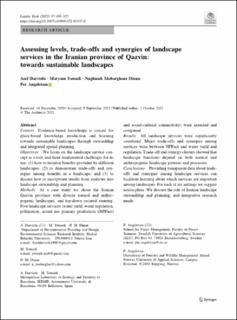| dc.contributor.author | Darvishi, Asef | |
| dc.contributor.author | Yousefi, Maryam | |
| dc.contributor.author | Dinan, Naghmeh Mobarghaee | |
| dc.contributor.author | Angelstam, Per Krister | |
| dc.date.accessioned | 2022-06-22T12:13:00Z | |
| dc.date.available | 2022-06-22T12:13:00Z | |
| dc.date.created | 2022-02-15T23:52:44Z | |
| dc.date.issued | 2021 | |
| dc.identifier.citation | Landscape Ecology. 2021, 1-23. | en_US |
| dc.identifier.issn | 0921-2973 | |
| dc.identifier.uri | https://hdl.handle.net/11250/3000065 | |
| dc.description.abstract | Context Evidence-based knowledge is crucial for place-based knowledge production and learning towards sustainable landscapes through stewardship and integrated spatial planning. Objectives We focus on the landscape service concept as a tool, and three fundamental challenges for its use: (1) how to monitor benefits provided by different landscapes; (2) to demonstrate trade-offs and synergies among benefits in a landscape; and (3) to discuss how to incorporate results from analyses into landscape stewardship and planning.
Methods: As a case study we chose the Iranian Qazvin province with diverse natural and anthropogenic landscapes, and top-down societal steering. Five landscape services (water yield, water regulation, pollination, actual net primary production (NPPact) and social-cultural connectivity) were assessed and compared.
Results: All landscape services were significantly correlated. Major trade-offs and synergies among services were between NPPact and water yield and regulation. Trade-off and synergy clusters showed that landscape functions depend on both natural and anthropogenic landscape patterns and processes.
Conclusions: Providing transparent data about tradeoffs and synergies among landscape services can facilitate learning about which services are important among landscapes. For each of six settings we suggest action plans. We discuss the role of Iranian landscape stewardship and planning, and integrative research needs | en_US |
| dc.language.iso | eng | en_US |
| dc.relation.uri | https://doi-org.ezproxy.inn.no/10.1007/s10980-021-01337-0 | |
| dc.rights | Navngivelse 4.0 Internasjonal | * |
| dc.rights.uri | http://creativecommons.org/licenses/by/4.0/deed.no | * |
| dc.subject | Ecosystem services | en_US |
| dc.subject | GIS | en_US |
| dc.subject | Landscape ecology | en_US |
| dc.subject | Social-ecological systems | en_US |
| dc.subject | Adaptive management | en_US |
| dc.subject | Spatial planning | en_US |
| dc.title | Assessing levels, trade-offs and synergies of landscape services in the Iranian province of Qazvin: towards sustainable landscapes | en_US |
| dc.type | Peer reviewed | en_US |
| dc.type | Journal article | en_US |
| dc.description.version | publishedVersion | en_US |
| dc.subject.nsi | VDP::Matematikk og Naturvitenskap: 400 | en_US |
| dc.source.pagenumber | 305-327 | en_US |
| dc.source.volume | 37 | en_US |
| dc.source.journal | Landscape Ecology | en_US |
| dc.source.issue | 1 | en_US |
| dc.identifier.doi | 10.1007/s10980-021-01337-0 | |
| dc.identifier.cristin | 2002088 | |
| cristin.ispublished | true | |
| cristin.fulltext | original | |
| cristin.qualitycode | 1 | |

